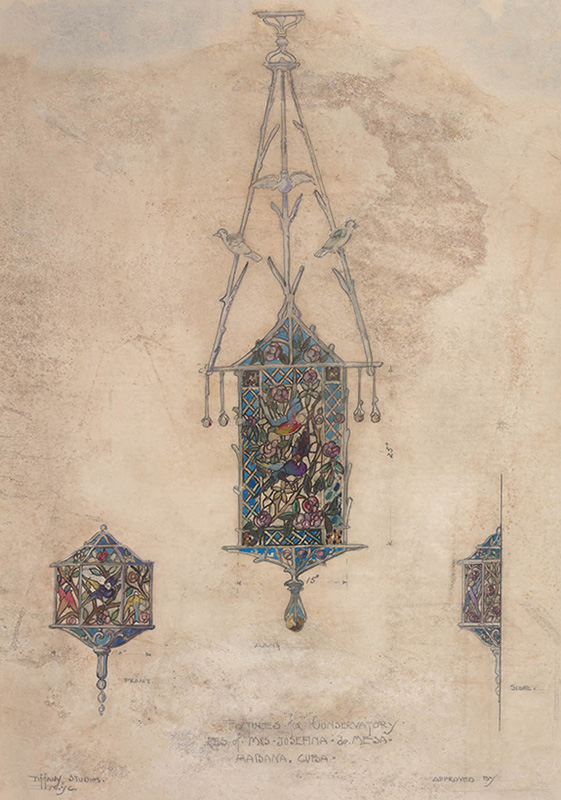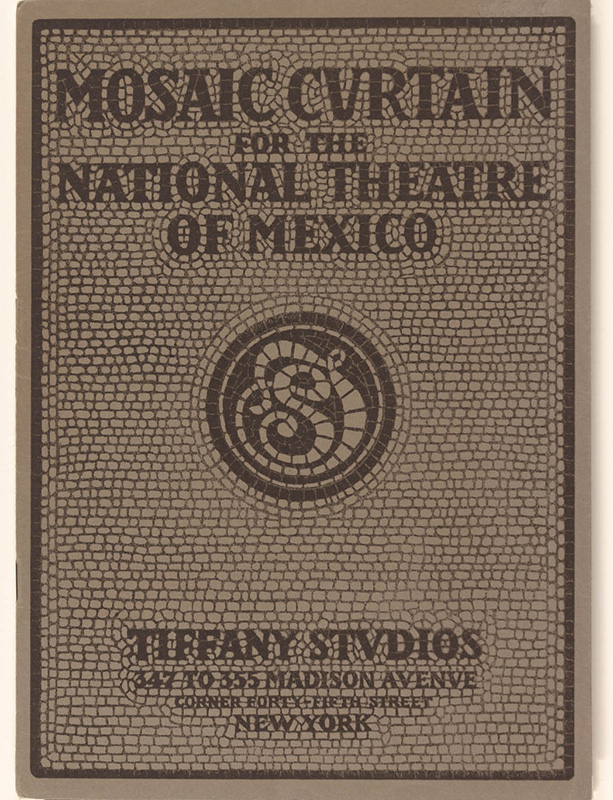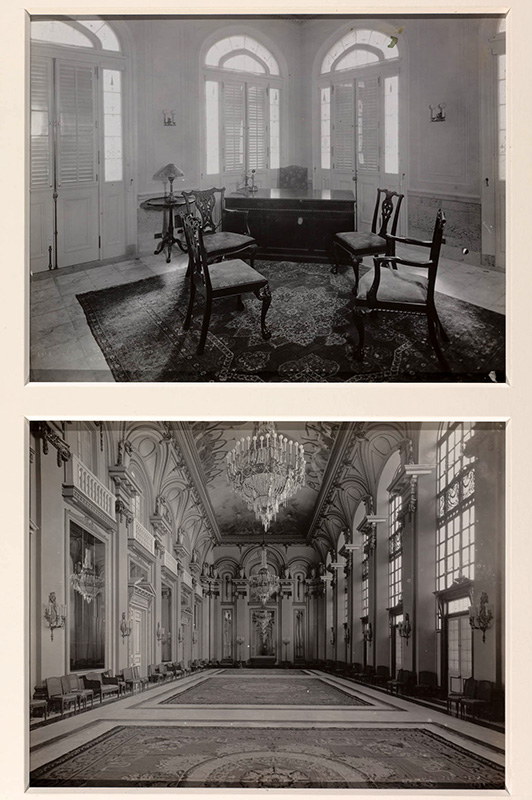Louis C. Tiffany and Latin America: A New Installation at The Metropolitan Museum of Art
by Juliana Fagua Arias
In the 1960s, The Metropolitan Museum of Art acquired a collection of watercolors from the studios of Louis Comfort Tiffany (1848–1933). These design drawings—which depict stained glass windows and architectural decorations among other elements—were created by different designers at Tiffany Studios as presentations to clients or as working documents for the execution of commissions. Two drawings from this collection illustrate an understudied but extremely fascinating subject: Tiffany Studios’ commissions in Latin America, specifically Mexico and Cuba.
One recently identified drawing (figure 1) illustrates a proposed design for the central dome of the Palacio de Bellas Artes in Mexico City (1909–1912), and the other (figure 2) shows designs for the lighting fixtures of the Havana residence of Mrs. Josefina de Mesa (1915–1916). From roughly 1908 to 1920, the prestigious design studio not only worked for some of the wealthiest clients in these countries, but decorated buildings that would become national landmarks. Moreover, these commissions were embedded in a discourse of progress and modernity that aimed to position Mexico City and Havana as cosmopolitan centers rivaling New York or Paris. Tiffany’s aesthetic and international reputation perfectly matched that goal.
Figure 1. Tiffany Studios, Design for the central dome of the Palacio de Bellas Artes in Mexico City, 1909–1912. The Metropolitan Museum of Art, 67.654.59.
Earlier this month, an installation opened in The Met’s American Wing that showcases these drawings for the very first time, a project that I am honored to have co-curated with Alice C. Frelinghuysen, the Anthony W. and Lulu C. Wang Curator of American Decorative Arts.
Tiffany in Mexico
The famed Palacio de Bellas Artes in Mexico City houses one of the largest and most splendid commissions ever undertaken by Tiffany Studios, a glass mosaic stage curtain depicting the snow-capped peaks of the legendary volcanoes Popocateptl and Iztaccíhuatl (figure 3). A masterpiece occupying 2,500 square feet and weighing 27 tons, the fireproof curtain contains nearly one million pieces of iridescent Favrile glass. Adamo Boari, the architect in charge of the construction of the Palacio de Bellas Artes of Mexico City, selected Tiffany for this commission over other international design studios precisely because of the shimmering and reflective qualities of Favrile glass, which he could not find in either Bohemian or Venetian glass.
Executed under the close supervision of Louis C. Tiffany, the curtain required about 15 months and the devotion of 20 mosaic workers. The glass was made at the Tiffany Furnaces and the bronze work for the frame was executed in the Tiffany Studios Metal Factory, both at Corona, Long Island. Finished in 1911, this “poem in glass” was displayed in the Tiffany Studios showrooms in New York City and its exhibition was accompanied by a pamphlet that advertised the commission and relayed its execution in romantic detail (figure 4). The curtain was shipped to Mexico and installed in 1912, months before the construction of the theater came to an abrupt halt due to the revolution, a conflict that lasted from 1910 until approximately 1920. Despite ending the decades-long regime of President Porfirio Diaz, the revolt resulted in a succession of unstable governments and armed rebellions famously led by the revolutionary Emiliano Zapata.
The authorship of the curtain’s design remains a controversy. Although Tiffany Studios sent their own artists to Mexico City to create inspirational landscape studies and sketches, archival evidence points to the Hungarian artist Geza Maroti (1875–1941) as the original source of the design. Maroti executed three pieces for the theater that can still be seen today: the mosaic proscenium arch above the curtain, the giant glass rosette at the center of the theater’s ceiling, and the sculpture group that crowns the central dome of the theater.
Interestingly enough, the watercolor in The Met’s collection does not illustrate the celebrated mosaic curtain. Rather, it shows a proposed design for the central dome that includes sculptures by Geza Maroti and Italian artist Leonardo Bistolfi. In the drawing, seven landscape panels, possibly mosaics or leaded glass, punctuate the windows of the dome, lined with enameled copper plates in a beaux-arts style. This proposal, however, was never realized, and the domes remained unfinished for two decades. Today, the domes show undecorated windows and follow the Art Deco style preferred by architect Federico Mariscal (1881–1971), under whose leadership the construction of the theater was resumed in the 1930s.
Tiffany in Cuba
Throughout the 19th century and early 20th century, New York City and Cuba had strong cultural, commercial, and political ties. Before Cuba’s independence in 1898, New York City was a safe haven for Cuban exiles who wanted to remain close to their country and active in its revolution. Between the 1840s and 50s there was even a short-lived annexationist movement that favored the United States incorporating the island. An industrial city that profited from processing raw brown sugar, New York was also the main port handling most of the sugar entering the United States from Cuban plantations. Several Cuban “sugarocrats” resided between Cuba and New York. They spent summers in the United States, sent their sons to boarding school or to intern at counting houses, and brought the latest fashion trends to Cuba. In this context, Tiffany Studios executed at least two interior design commissions in Havana between 1916 and 1920, the mansion of Josefina de Mesa and the Presidential Palace for Cuba’s third elected president, Mario Garcia Menocal, and his wife Mariana Seva y Rodriguez.
A watercolor in The Met’s collection illustrates designs for lighting fixtures for the conservatory of the residence of de Mesa, as specified in an inscription found on the drawing. The design shows a hanging leaded glass lantern suspended from three poles in the form of tree twigs with birds perched on them. A wall sconce with similar motifs is also depicted. The theme of nature dominates the composition in line with Tiffany’s fascination with organic and vegetal forms. Josefina de Mesa and her late husband, Tirso Mesa, owned several plantations in Cuba but spent a significant amount of time traveling between Europe, the United States, and Cuba. They may have first encountered Tiffany’s work when Mr. Mesa visited the 1889 Paris exposition, where Tiffany exhibited.
Mrs. Mesa’s residence, currently the Chinese embassy, is located in the Havana neighborhood of Vedado, a western suburb near the coast that provided affluent families an escape from the summer heat. Whether this design was realized or not is unclear, but it is possible that the residence, and even other mansions in the neighborhood, still display some decorative elements by Tiffany.
Also displayed in the rotation are two photos of the interiors of the former presidential palace of Havana, which Tiffany Studios decorated (figure 5). Originally intended to be the capitol of the province of Havana, construction began in 1914. In 1917, First Lady Mariana Seva visited the premises. Captivated by its magnificence, she decided to move the presidential residence to this building. At that juncture Tiffany was commissioned to design the interiors, which comprised four floors and a roof garden. Tiffany employed several different styles for the rooms, including French Neoclassical-style panels for the dining room, Empire-style mahogany furniture for the President’s office, and a Hall of Mirrors that recalls Versailles, with ceilings decorated with allegorical murals by Cuban artist Armando Menocal. French and Oriental rugs, artistic bronze lamp-posts, and rattan chairs, among other objects either made or sourced by Tiffany, decorated the interior. Currently, the Palace houses the Museum of the Revolution, and showcases objects related to the revolutionary fight against president Batista in 1959.
This rotation will be on view until November 2022 in the American Wing’s Tiffany galleries (gallery 743).
Juliana Fagua Arias is a contributing writer for The Decorative Arts Trust Bulletin and recently concluded her tenure as the Tiffany & Co. Foundation Curatorial Intern in The Met’s American Wing.
About The Decorative Arts Trust Bulletin
Formerly known as the "blog,” the Bulletin features new research and scholarship, travelogues, book reviews, and museum and gallery exhibitions. The Bulletin complements The Magazine of the Decorative Arts Trust, our biannual members publication.












